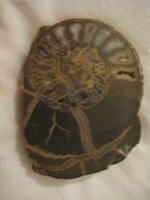- Joined
- Mar 8, 2004
- Messages
- 4,883
I was in Santa Monica the other day, so I looked for a fossil shop hallucigenia told me about: Jurassic Gallery - Dinosaur Fossil display Specimens for your Home
They had quite an impressive array of fossils of various sorts, including a lot of shelled cephs. Being in Santa Monica, their prices were a bit steeper than the rock seller at the Hilo farmer's market where I got my last fossils, but they made up for it in selection... and they had a few "grab bag" baskets of ammonites and pieces of slate/shale (?) with ammonite impressions (and one thing that looked like a jellyfish; I was wondering if it's some Cambrian thingie...)
Anyway, the guy who was there, Bobby, showed me one that was his "favorite ammonite" because it was cut right through the siphuncle, and is rather nice looking. Since I'm trying to learn a bit of the ID techniques, I was a bit mystified, since it looked a lot like a nautiloid to me. As it turns out, they're not terribly expert at IDing fossil cephs, since neither knew what a nautiloid is or how it differs from an ammonite, so I suspect I'm on the right track... anyway, I decided to buy it (probably unwise until I get a new job, but he suckered me in by discounting it because of my obvious enthusiasm...)
They didn't have any record of where the fossil came from, but they did have a book Ammonites and Other Cephalopods if the Pierre Seaway Identification Guide (by Larson, Jorgensen, Farrar, and Larson) which described some nautiloids found there, and the closest one seemed to be Rutrephoceras dekayi var. montanaensis but I didn't have much to go on... it certainly seems to have a lot of nautiloid characteristics: central siphuncle, smooth septa, apparently simple sutures (although they're not really visible) and no visible ornamentation. I think it's involute, but it's hard to tell.
Anyway, here's some pix, anyone want to take a guess, or tell me I've made a novice mistake?
They had quite an impressive array of fossils of various sorts, including a lot of shelled cephs. Being in Santa Monica, their prices were a bit steeper than the rock seller at the Hilo farmer's market where I got my last fossils, but they made up for it in selection... and they had a few "grab bag" baskets of ammonites and pieces of slate/shale (?) with ammonite impressions (and one thing that looked like a jellyfish; I was wondering if it's some Cambrian thingie...)
Anyway, the guy who was there, Bobby, showed me one that was his "favorite ammonite" because it was cut right through the siphuncle, and is rather nice looking. Since I'm trying to learn a bit of the ID techniques, I was a bit mystified, since it looked a lot like a nautiloid to me. As it turns out, they're not terribly expert at IDing fossil cephs, since neither knew what a nautiloid is or how it differs from an ammonite, so I suspect I'm on the right track... anyway, I decided to buy it (probably unwise until I get a new job, but he suckered me in by discounting it because of my obvious enthusiasm...)
They didn't have any record of where the fossil came from, but they did have a book Ammonites and Other Cephalopods if the Pierre Seaway Identification Guide (by Larson, Jorgensen, Farrar, and Larson) which described some nautiloids found there, and the closest one seemed to be Rutrephoceras dekayi var. montanaensis but I didn't have much to go on... it certainly seems to have a lot of nautiloid characteristics: central siphuncle, smooth septa, apparently simple sutures (although they're not really visible) and no visible ornamentation. I think it's involute, but it's hard to tell.
Anyway, here's some pix, anyone want to take a guess, or tell me I've made a novice mistake?




 to all you fossils & history folks, really. I'm just glad I've got access to all you folks' encyclopedic knowledge!
to all you fossils & history folks, really. I'm just glad I've got access to all you folks' encyclopedic knowledge! 
 research and concept memory, but I am in awe of so many folks around here in this regard I feel silly to be called out... of course, I guess you just said I would have a lot to say and it would involve science jargon, and that I can probably admit to even if I don't know a whosawhatsis magnificus from a habeas corpus.
research and concept memory, but I am in awe of so many folks around here in this regard I feel silly to be called out... of course, I guess you just said I would have a lot to say and it would involve science jargon, and that I can probably admit to even if I don't know a whosawhatsis magnificus from a habeas corpus.

 being fiendish
being fiendish